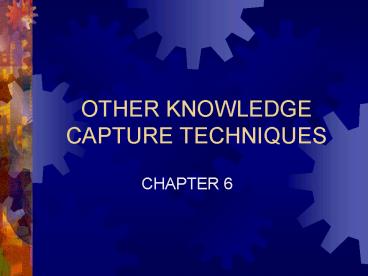OTHER KNOWLEDGE CAPTURE TECHNIQUES - PowerPoint PPT Presentation
1 / 20
Title:
OTHER KNOWLEDGE CAPTURE TECHNIQUES
Description:
Process of observing, interpreting, and recording problem-solving behavior while ... Has been known to promote impatience among experts who must listen to ... – PowerPoint PPT presentation
Number of Views:155
Avg rating:3.0/5.0
Title: OTHER KNOWLEDGE CAPTURE TECHNIQUES
1
OTHER KNOWLEDGE CAPTURE TECHNIQUES
- CHAPTER 6
2
On-Site Observation
- Process of observing, interpreting, and recording
problem-solving behavior while it takes place - More listening than talking
- Some experts do not like to be observed
- Fear of giving away expertise is a concern by
the one observed - Process can be distracting to others in the
setting - Continuous shuttle process important
3
Brainstorming
- Unstructured approach to generating ideas about a
problem - All possible solutions considered equally
- Emphasis is on frequency of responses during the
session - Idea generation, followed by idea evaluation
4
Brainstorming Procedure
- Introduce brainstorming session
- Give experts a problem to consider
- Prompt experts to generate ideas
- Watch for signs of convergence
- Call for a vote or a consensus to reach agreement
5
Electronic Brainstorming
- Computer-aided approach to dealing with multiple
experts - Begins with a presession plan that identifies
objectives and structures the agenda - Experts gain leverage from anonymity
- Allows two or more experts to provide opinions
through PCs without having to wait their turn - Protects shy experts and prevents tagging
comments to individuals
6
Protocol Analysis
- Think-aloud method
- Expert keeps talking, speaking out loud while
solving a problem - Effective source of information on cognitive
processes - Makes expert cognizant of the processes being
described - Provides wealth of information toward knowledge
representation
7
Consensus Decision Making
- Clear agreement regarding the best solution to a
problem - As a tool, it follows brainstorming
- Procedure ensures fairness and standardization in
the way experts arrive at a consensus - A bit tedious and can take hours
- The rigidity of the consensus method can be a
problem for many experts
8
The Repertory Grid
- Domain expert viewed as a scientist who
categorizes a problem domain using his or her own
model - Grid used to capture and evaluate the experts
model - Experts see problems based on reasoning that has
stood test of time - A representation of the experts way of looking
at a particular problem - A grid is a scale or a bipolar construct on which
elements are placed within gradations
9
The Repertory Grid (contd)
- Benefit May prompt the expert to think more
seriously about the problem and how to solve it. - Drawback Difficult to manage when large grids
are accompanied by complex details - Because of difficulty in simplicity and
manageability, the tool is normally used in the
early stages of knowledge capture
10
Nominal Group Technique (NGT)
- Mitigates the process losses associated with
multiple experts - An alternative to the consensus technique
- Provides an interface between consensus and
brainstorming - Panel of experts becomes a nominal group whose
meetings structured in order to effectively pool
individual judgment - An ideawriting or idea generation technique
11
NGT (contd)
- Technique can be time consuming
- Has been known to promote impatience among
experts who must listen to discussions with other
experts - With experts sharing expertise, things can jell
in adopting the best solution - NGT is ideal in situations of uncertainty
regarding the nature of the problem
12
NGT (contd)
- Effective in multiple expert knowledge capture,
especially when minimizing differences in status
among experts is important - In NGT, each expert has an equal chance to
express ideas in parallel with other experts in
the group - With discussion accommodated in sequential order,
NGT can be a more efficient and productive
approach than brainstorming
13
Delphi Method
- A survey of experts
- A series of questionnaires used to pool experts
responses in order to solve a difficult problem - Each experts contributions shared with rest of
experts by using results of one questionnaire to
construct the next questionnaire - Anonymous response
14
Delphi Method (contd)
- Controlled feedback
- Statistical group response
- Experts often lack necessary knowledge on which
to base final judgment - Poorly designed questionnaire could cause all
kinds of problems
15
Concept Mapping
- A network of concepts, consisting of nodes and
links - A node represents a concept and a link represents
the relationship between concepts. See Fig. 6.5 - An effective way for a group to function without
losing their individuality
16
Figure 6.5 Conceptual MapAn Example
White horse
Beard
At chimneys
On roofs
Birthday
has
rides
Spain
listens
has
climbs
lives in
lives in
SAINT NICOLAS
helper of
BLACK PETER
brings
gives
not same as
Santa Clause
Presents
17
Figure 6.6 Steps in Concept Mapping
1 Preparation of Project Participants, focus,
schedule
2 Idea Generation (focus for brainstorming)
6 Utilization
STEPS IN CONCEPT MAPPING
3 Idea Structuring (sorting/rating statements)
4 Statement Representation
5 Interpretation (cluster analysis)
18
Blackboarding
- Assumes all participants are experts with unique
experience - Each expert has equal chance to contribute to the
solution via the blackboard - Process continues until the problem has been
solved - Diverse approaches to problem solving
19
Blackboarding (contd)
- Participants share a common language for
interaction - Flexible representation of information
- Efficient storage and location of information
- Organized participation
- Iterative approach to problem solving
20
OTHER KNOWLEDGE CAPTURE TECHNIQUES
- CHAPTER 6































